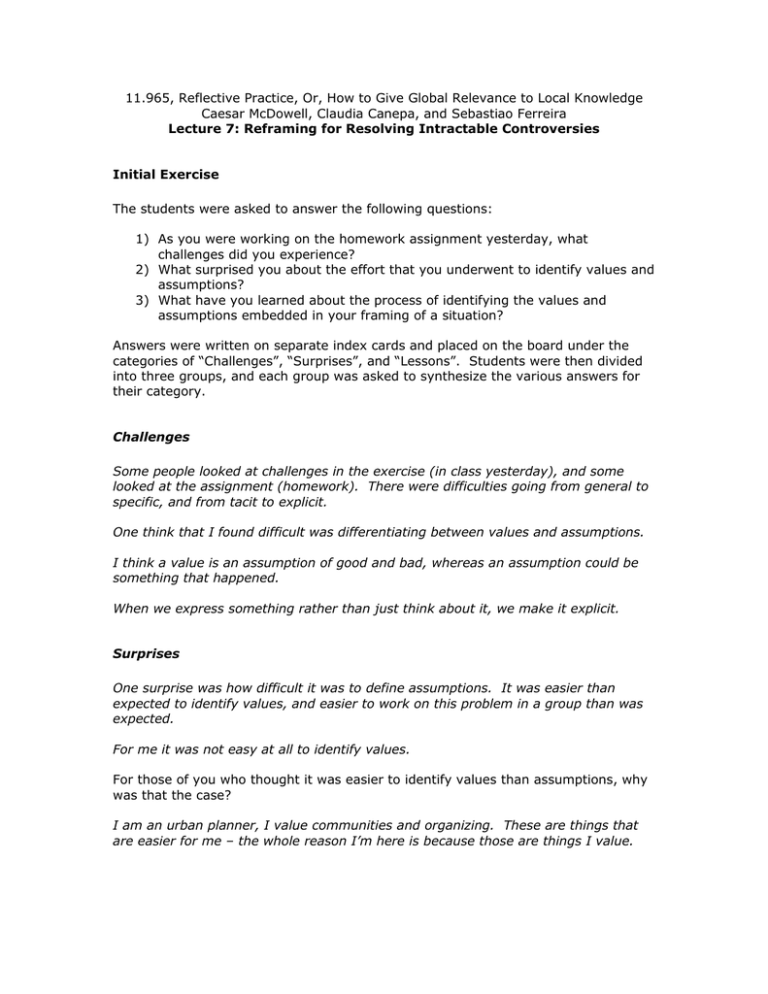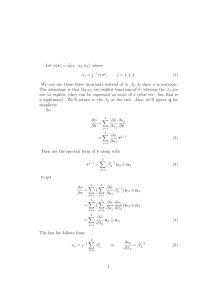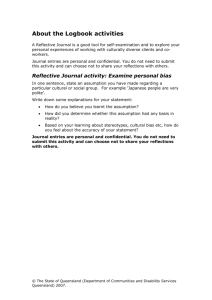11.965, Reflective Practice, Or, How to Give Global Relevance to... Caesar McDowell, Claudia Canepa, and Sebastiao Ferreira
advertisement

11.965, Reflective Practice, Or, How to Give Global Relevance to Local Knowledge Caesar McDowell, Claudia Canepa, and Sebastiao Ferreira Lecture 7: Reframing for Resolving Intractable Controversies Initial Exercise The students were asked to answer the following questions: 1) As you were working on the homework assignment yesterday, what challenges did you experience? 2) What surprised you about the effort that you underwent to identify values and assumptions? 3) What have you learned about the process of identifying the values and assumptions embedded in your framing of a situation? Answers were written on separate index cards and placed on the board under the categories of “Challenges”, “Surprises”, and “Lessons”. Students were then divided into three groups, and each group was asked to synthesize the various answers for their category. Challenges Some people looked at challenges in the exercise (in class yesterday), and some looked at the assignment (homework). There were difficulties going from general to specific, and from tacit to explicit. One think that I found difficult was differentiating between values and assumptions. I think a value is an assumption of good and bad, whereas an assumption could be something that happened. When we express something rather than just think about it, we make it explicit. Surprises One surprise was how difficult it was to define assumptions. It was easier than expected to identify values, and easier to work on this problem in a group than was expected. For me it was not easy at all to identify values. For those of you who thought it was easier to identify values than assumptions, why was that the case? I am an urban planner, I value communities and organizing. These are things that are easier for me – the whole reason I’m here is because those are things I value. My surprise was that I had a negative sensation around how much we compromised. I was realizing as I did the homework assignment how much we gave in to come to a common description of the problem. I think it’s always hard to assume you are committed to certain values. It’s like a personal identification with a problem, it’s more than an abstract analysis. Lessons We thought it was important to be conscious of what was going on underneath. It was difficult to make the values explicit, but it was very important to make the thinking explicit. Once you get things out into the open, it is easier to incorporate things into a shared framework. One of the lessons is about identifying weaknesses within your argument. Parts of the argument may be missing or inconsistent. Presentation – Analyzing Frames: The Art of Discovering Underlying Assumptions and Values in Frames What is interesting about this example is that they use two elements for naming the frame, a short name (Unreliable Sources, for example) and a longer description. Perhaps it is good for us to give names to the frames from yesterday. There are different kinds of assumptions. “X thousand people use Open Courseware each year.” I can get data and verify this assumption. When a physician is making a diagnosis, he makes many assumptions. This kind of assumption is easy to verify. The second type of assumption is about causal relations. “Democracy improves the quality of life.” This kind is about how I think the world works. There is also a value there, right? The statement contains values, but it is not about values. I can do research to verify this, but it would not be just about raw data. For example, in Peru, many traders have this idea that it’s impossible to reach the market of Lima. We can challenge these assumptions with examples of how things work differently. The cause and effect relationship may not be so absolute. When it is tacit, we call it an assumption. When it is made explicit, we call it a hypothesis. Values are criteria. It is impossible to verify if a value is true or false. When we have some values, we frame the situation in different ways. Different frames are based on different values. The box is invisible, so it is very hard to discover assumptions. People outside of our mind are much better at identifying our assumptions. “A good practice is to talk to people who disagree profoundly with us.” This will help us discover our assumptions, and it will disturb our framework. 11.965, Reflective Practice McDowell, Canepa, and Ferreira Lecture 7 Page 2 of 3 When we write an assumption, we should make an effort to make it falsifiable, to formulate in a way where I can verify if it is true or not true. You identify the problem, some factors that generate the problem, and the impact of the problem. This is how we organized our frame about the situation in Framingham. Why do you think this problem will produce this impact? We can question the scenario as a whole, and components of the scenario, to get more detailed assumption. After that we will try to do the same analysis of the factors. Why do you think this factor generated the scenario? Are there some conditions we did not state yesterday? How did they cause the situation? For exploring values: why do you think it is a problem? Why are you concerned about the scenario, why do you think it is bad? Those reasons are values. Also, motivations – we should try to discover what kind of values or elements we were trying to protect or reinforce. Some values may be my interests. I may be putting my interests into the form of a value. This is very frequent in political discussions – a group presenting their interests as values. Looking for interests and motivations is a way to find values. Do you think scenario planning is a good way to get at values and assumptions? Scenario planning emerged as a way to make assumptions explicit. All the other companies assumed the price of oil should go up again. Shell assumed that it would be stable, so they invested in refineries, while the other companies invested in exploration. Can you also use it to make values explicit? No, it’s not so effective for making values explicit. You can analyze the scenario to get at values, but it’s not a reason for doing scenario planning. Group Exercise In the same groups as yesterday, students were asked to answer the following questions: Values 1) Why do you think that is a problem? 2) Why are you concerned with the impact? Assumptions 1) Why do you think that the problem will generate the impact that you expect? 2) Why do you believe that these factors are causing the problem? Analyze each separately. 11.965, Reflective Practice McDowell, Canepa, and Ferreira Lecture 7 Page 3 of 3


